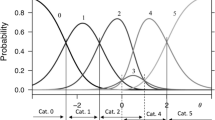Abstract
An experiment was conducted in order to assess the effects of three independent variables, rater training (accuracy versus error versus dimension), job analysis format (descriptions versus specifications) and congruence of training (congruent versus incongruent) on differential accuracy and halo and leniency error of job evaluation ratings. Subjects were 144 college students at a large midwestern university. The results indicated a significant main effect for job analysis format on all three dependent variables and a significant training X job analysis format effect on halo error. These results suggest at least some similarity in the processes across different types of rating tasks.
Similar content being viewed by others
References
Bernardin, H.J., & Pence, E.C. (1980). Effects of rater training: Creating new response sets and decreasing accuracy.Journal of Applied Psychology, 65, 60–66.
Blumrosen, R.G. (1979). Wage discrimination, job segregation, and Title VII of the Civil Rights Act of 1964.Journal of Law Reform, 12, 397–502.
Borman, W.C. (1975). Effects of instructions to avoid halo error on reliability and validity of performance evaluation ratings.Journal of Applied Psychology, 60, 556–560.
Borman, W.C. (1977). Consistency of rating accuracy and rating errors in the judgment of human performance.Organizational Behavior and Human Performance, 20, 238–252.
Borman, W.C. (1979). Format and training effects on rating accuracy and rating errors.Journal of Applied Psychology, 64, 412–421.
Cascio, W.F. (1982).Applied psychology in personnel management (2nd ed.). Reston, VA: Reston.
Cellar, D.F., Durr, M.L., Halsell, S., & Doverspike, D. (1989). The effects of cognitive style, job analysis format, and the sex of rater on job evaluation accuracy.Journal of Applied Social Psychology, 19, 363–376.
Doverspike, D. (1983). A statistical analysis of internal sex bias in a job evaluation instrument (Doctoral dissertation, University of Akron).Dissertation Abstracts International, 43, 3063B.
Doverspike, D., & Barrett, G.V. (1984). An internal bias analysis of a job analysis instrument.Journal of Applied Psychology, 69, 648–662.
Dunnette, M.D., & Borman, W.C. (1979). Personnel selection and classification systems.Annual Review of Psychology, 30, 477–525.
Feldman, J.M. (1981). Beyond attribution theory: Cognitive processes in performance appraisal.Journal of Applied Psychology, 66, 127–148.
Giese, S.L. (1985).Comparison of a point method job evaluation instrument using student raters and professional raters. Unpublished manuscript, Department of Psychology, University of Akron.
Goldstein, I.L. (1986).Training in organizations. Monterey, CA: Brooks, Cole.
Grams, R., & Schwab, D.P. (1985). An investigation of systematic gender-related error in job evaluation.Academy of Management Journal, 28, 279–290.
Henderson, R.I. (1982).Compensation management: Rewarding performance. Reston, VA: Reston.
Lord, R.G., & Foti, R.J. (1986). Schema theories, information processing, and organizational behavior. In H.P. Sims Jr. & D.A. Gioia (Eds.),The thinking organization (pp. 20–48). San Francisco: Jossey-Bass.
Milkovich, G.T., & Newman, J.M. (1984).Compensation. Piano, TX: Business Publications, Inc.
Pulakos, E.D. (1984). A comparison of rater training programs: Error training and accuracy training.Journal of Applied Psychology, 69, 581–588.
Saal, F., Downey, J., & Lahey, M.A. (1980). Rating the ratings.Psychological Bulletin, 87, 346–365.
Schwab, D.P., & Grams, R. (1985). Sex-related errors in job evaluation. A “real-world” test.Journal of Applied Psychology, 70, 533–539.
Smith, D.E. (1986). Training programs for performance appraisal: A review.Academy of Management Review, 11, 22–40.
Thorndike, E.L., & Woodworth, R.S. (1901). (I) The influence of improvement in one mental function upon the efficiency of other functions. (II) The estimation of magnitudes. (III) Functions involving attention, observation, and discrimination.Psychological Bulletin, 8, 247–261, 384–385, 553–564.
Treiman, D.J., & Hartmann, H.I. (Eds.). (1981).Women, work, and wages: Equal pay for jobs of equal value. Washington: National Academy Press.
U.S. Department of Labor. (1977).Dictionary of occupational titles (4th ed.). Washington, DC: U.S. Government Printing Office.
Author information
Authors and Affiliations
Rights and permissions
About this article
Cite this article
Cellar, D.F., Curtis, J.R., Kohlepp, K. et al. The effects of rater training, job analysis format and congruence of training on job evaluation ratings. J Bus Psychol 3, 387–401 (1989). https://doi.org/10.1007/BF01020707
Issue Date:
DOI: https://doi.org/10.1007/BF01020707




